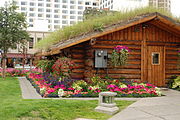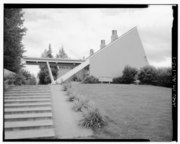
Carson & Lundin, later known as Carson, Lundin & Shaw and Carson, Lundin & Thorson, was an American architectural firm based in New York City and active from 1941 until 1996. It was formed initially by the 1941 partnership between architects Robert Carson and Earl H. Lundin.

Harold B. Foss (1910–1988) was an American architect from Juneau, Alaska.

N. Lester Troast (1899–1958) was an American architect from Sitka and Juneau, Alaska, who was one of the first professional architects to practice in Alaska.
Daphne Elizabeth Brown (1948–2011) was an American architect who was posthumously inducted into the Alaska Women's Hall of Fame and awarded the Kumin Award from the American Institute of Architects, the highest recognition for architectural achievement in Alaska.

Manley & Mayer was an American architectural firm in Alaska, and was the leading firm in Anchorage for several decades.

Glenn Stanton (1895–1969) was an American architect in practice in Portland, Oregon, from 1925 until 1969. From 1951 to 1953 he was president of the American Institute of Architects.

Leon Chatelain Jr. (1902–1979) was an American architect in practice in Washington, D.C., from 1932 to 1974. From 1956 to 1958 he was president of the American Institute of Architects.

Robert L. Durham (1912–1998) was an American architect in practice in Seattle from 1941 to 1977. He was president of the American Institute of Architects for the year 1967–68.

John A. Carter (1924–2017) was an American architect in practice in Nashua, New Hampshire, from 1953 to 1995.

William Marshall Jr. (1925–1997) was an American architect in practice in Norfolk, Virginia from 1955 to 1984 and was president of the American Institute of Architects for 1975.

Robert M. Lawrence was an American architect in practice in Oklahoma City. He was president of the American Institute of Architects for the year 1982.

G. Morris Whiteside II was an American architect in practice in Wilmington, Delaware from 1910 until his death in 1963.

Sherwood, Mills & Smith, known after 1968 as the SMS Partnership and as SMS Architects, was an American architecture firm active in Stamford and New Canaan, Connecticut from 1946 to 2000. Initially the partnership of architects Thorne Sherwood, Willis N. Mills and Lester W. Smith, the firm grew into one of the most influential in the region.

Ralph O. Mott was an American architect in practice in Fort Smith, Arkansas from 1935 until his retirement in 1993. For nearly sixty years, he was head of the Fort Smith architecture firm now (2024) known as MAHG Architecture and was president of the National Council of Architectural Registration Boards for the year 1965.

James William Kideney was an American architect in practice in Buffalo, New York from 1926 until his retirement in 1974. The firm he founded is still in business as Kideney Architects PC. He is the namesake of the James William Kideney Gold Medal Award, the highest honor awarded by AIA New York State.

Milton Milstein was an American architect in practice in Buffalo, New York from 1947 until his retirement in 1991. Milstein was a leader in the architectural and Jewish communities of western New York and was credited by his contemporaries with raising the standard of architectural design in the Buffalo area.

Arthur R. Mann was an English-born American architect and engineer in practice in Hutchinson, Kansas from 1909 until his retirement in 1965. In 1924 he formed the firm of Mann & Company, which remained under family ownership until 1977 and is still in business.

Robert J. Schaefer was an American architect in practice in Wichita, Kansas from 1957 until his retirement in 1993. Schaefer's practice, known since 2023 as Schaefer Architecture, has had a major role in the spread of modern architecture in Kansas.

Kenneth Maynard was an American architect in practice in Anchorage, Alaska from 1965 to 2011.

Elmer A. Stuck was an American architect in practice in Jonesboro, Arkansas from 1926 until his death in 1978.

































